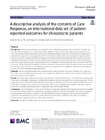| dc.contributor.author | Young, Kenneth J. | |
| dc.contributor.author | Fitzgerald, Jane | |
| dc.contributor.author | Field, Jonathan | |
| dc.contributor.author | Newell, Dave | |
| dc.contributor.author | Richards, Jim | |
| dc.date.accessioned | 2024-01-25T11:19:59Z | |
| dc.date.available | 2024-01-25T11:19:59Z | |
| dc.date.issued | 2023-09-19 | |
| dc.identifier.citation | Young, K. J., Fitzgerald, J., Field, J., Newell, D., & Richards, J. (2023). A descriptive analysis of the contents of Care Response, an international data set of patient-reported outcomes for chiropractic patients. Chiropractic & Manual Therapies, 31(1), 37. https://doi.org/10.1186/s12998-023-00509-w | en |
| dc.identifier.issn | 2045-709X | |
| dc.identifier.uri | https://aecc.archive.knowledgearc.net/handle/123456789/246 | |
| dc.description | Available under License - Creative Commons Attribution: https://creativecommons.org/licenses/by/4.0/ | en |
| dc.description.abstract | Background: Databases have become an important tool in understanding trends and correlations in health care by collecting demographic and clinical information. Analysis of data collected from large cohorts of patients can have the potential to generate insights into factors identifying treatments and the characteristics of subgroups of patients who respond to certain types of care. The Care Response (CR) database was designed to capture patient-reported outcome measures (PROMs) for chiropractic patients internationally. Although several papers have been published analysing some of the data, its contents have not yet been comprehensively documented. The primary aim of this study was to describe the information in the CR database. The secondary aim was to determine whether there was suitable information available to better understand subgroups of chiropractic patients and responsiveness to care. This would be achieved by enabling correlations among patient demographics, diagnoses, and therapeutic interventions with machine learning approaches.
Methods: Data in all available fields were requested with no date restriction. Data were collected on 12 April 2022. The output was manually scanned for scope and completeness. Tables were created with categories of information. Descriptive statistics were applied.
Results: The CR database collects information from patients at the first clinical visit, 14, 30, and 90 days subsequently. There were 32,468 patient responses; 3210 patients completed all fields through the 90 day follow up period. 45% of respondents were male; 54% were female; the average age was 49. There was little demographic information, and no information on diagnoses or therapeutic interventions. We received StartBack, numerical pain scale, patient global impression of change, and Bournemouth questionnaire data, but no other PROMs.
Conclusions: The CR database is a large set of PROMs for chiropractic patients internationally. We found it unsuitable for machine learning analysis for our purposes; its utility is limited by a lack of demographic information, diagnoses, and therapeutic interventions. However, it can offer information about chiropractic care in general and patient satisfaction. It could form the basis for a useful clinical tool in the future, if reformed to be more accessible to researchers and expanded with more information collected. | en |
| dc.language.iso | en | en |
| dc.publisher | Chiropractic & Manual Therapies | en |
| dc.subject | Chiropractic | en |
| dc.subject | Patient-reported outcome measures | en |
| dc.subject | Database | en |
| dc.subject | Descriptive analysis | en |
| dc.title | A descriptive analysis of the contents of Care Response, an international data set of patient-reported outcomes for chiropractic patients | en |
| dc.type | Article | en |
| dc.identifier.doi | https://doi.org/10.1186/s12998-023-00509-w | |
